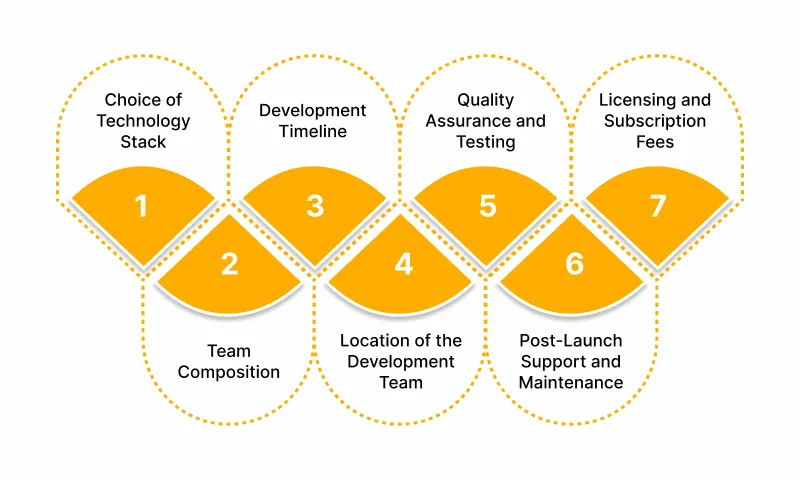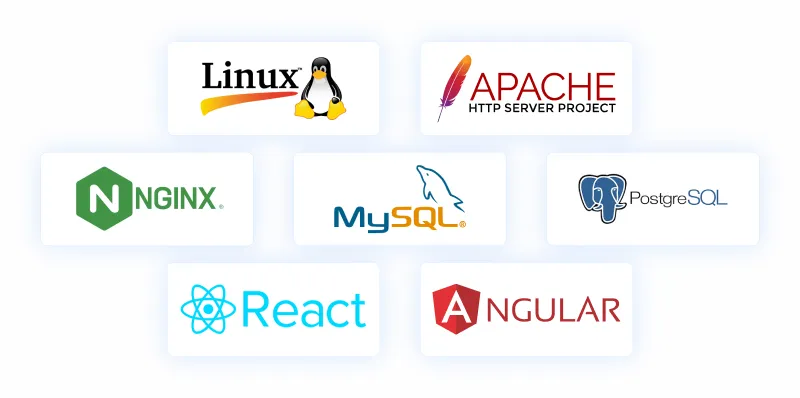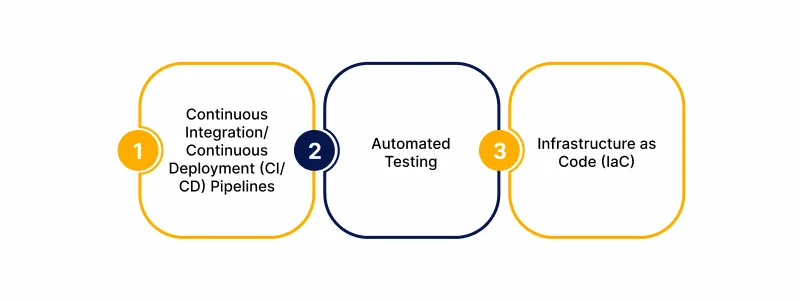Starting a new venture is a journey filled with potential, thrill, and opportunity. One of the biggest challenges most startups face is managing the high costs of developing new products/services.
Managing expenses effectively is difficult for startups during the early stages, where each penny counts, and resources are often limited. Without careful planning, these expenses can spiral out of control and threaten the viability of the business.
This blog post will discuss the practical and effective strategies for startup cost reduction. Whether you are just starting or looking to optimize your budget, these insights will help you deal with the financial challenges of the startup landscape and achieve sustainable success.
Factors Affecting the Cost of Custom Software Development
The following list represents the factors affecting the cost of custom software development, which can further help in startup cost reduction.
1. Choice of Technology Stack
The technologies and platforms used can significantly impact costs. Some technologies may require specialized skills or have higher licensing fees.
2. Team Composition
The overall cost is affected by the number and type of professionals involved (developers, designers, testers, project managers). Specialized skills may be more expensive.
3. Development Timeline
Urgent projects or those with tight deadlines may incur additional costs due to the need for overtime or additional staffing.
4. Location of the Development Team
Costs can vary based on whether the team is local, nearshore, or offshore. Different regions have different labor costs, and hiring in more economical regions (for example, by utilizing an employer of record in India) can often be more cost-effective.
5. Quality Assurance and Testing
Comprehensive testing and quality assurance add to the overall cost, especially if extensive testing is required.
6. Post-Launch Support and Maintenance
Ongoing support, updates, and maintenance—including bug fixes, performance enhancements, and feature additions—need to be factored into the total cost.
7. Licensing and Subscription Fees
Some projects may require third-party software, APIs, or services, which can add to the cost through licensing or subscription fees.
Discover efficient strategies to optimize your development budget.
How Much Does Custom Software Development Cost?
Custom software development costs vary according to several involved factors, including project complexity, development team location, and specific requirements. Here are some key points to consider when estimating price for startup cost reduction:
1. Project Scope and Complexity
Simple applications come with basic functionality with minimal features like a simple mobile app or website. On the other hand, applications with more features, integrations, and user interactions increase the cost such as e-commerce platforms or enterprise software
Moreover, highly complex systems involve large-scale applications with advanced features, high security, and extensive integrations, such as financial software or complex enterprise solutions.
Here is an estimate for the above-discussed applications:
Simple Applications: $10,000 – $50,000
Moderate Complexity: $50,000 – $100,000
Highly Complex Systems: $100,000 – $500,000+
2. Development Team
Freelancers, typically charge $25 – $150 per hour, depending on expertise and location. However, small development agencies rates usually range from $50 – $200 per hour.
Furthermore, large development firms can charge $150 – $300+ per hour, offering a full range of offshore software development services.
Also, the location of the development may increase your development cost. North America and Western Europe has generally higher rates due to the cost of living and demand for skilled developers.
On the other hand, Eastern Europe, Asia, and Latin America are more cost-effective if you hire app developers in India.
3. Other Important Considerations
Usually, the short-term projects may incur higher hourly rates due to the need for rapid development. On the other hand, long-term projects benefit from negotiated rates and bulk discounts.
Other factors include costs for maintenance and updates (Ongoing costs for bug fixes, updates, and new features), licensing and hosting (Costs for software licenses, server hosting, and other third-party services), and user training and support (Expenses for training users and providing customer support)
Also read:Top 11 Software Product Development Companies
Top Strategies for Reducing High Development Costs
Have a look at the following strategies for navigating startup challenges:
1. Planning and Prioritizing
You must clearly define your business project goals at first, to avoid scope creep, which can significantly increase development costs.
By establishing a detailed project scope, you ensure that all stakeholders are on the same page and that the development team knows exactly what is expected.
Prioritize the features that offer the most value to your users and align with your business goals. Use techniques like MoSCoW (Must have, Should have, Could have, Won’t have) to categorize features and focus on the most critical ones.
An MVP allows you to launch a product with just enough features to satisfy early adopters. This approach helps you validate your business idea with minimal resources, gather user feedback, and make data-driven decisions for future development.
For example, Dropbox initially launched a simple video demonstrating its product concept to gauge interest before developing the full product. This strategy helped them attract early users and secure funding without incurring high development costs.
2. Use Open Source Solutions
Open-source software offers a cost-effective alternative to proprietary solutions, providing startups with access to high-quality tools and libraries without licensing fees. The benefits of using open-source tools include:
- Cost Savings: Open-source software is typically free to use, reducing the initial and ongoing costs associated with software licenses.
- Flexibility and Customization: Open source solutions can be modified to meet specific needs, allowing businesses to tailor the software to their exact requirements.
- Community Support: A vibrant community often surrounds popular open-source projects, offering support, updates, and enhancements.
- Security and Transparency: Open source code can be audited for security vulnerabilities, providing greater transparency and trust in the software.
Some examples of popular open-source development solutions include Linux, Apache, Nginx, MySQL, PostgreSQL, React, and Angular.
Low-code and no-code platforms enable the rapid development of applications with minimal hand-coding, using visual interfaces and pre-built components. This approach leads to Startup cost reduction. Key benefits include:
- Speed to Market: These platforms accelerate the development process, allowing businesses to launch products faster and respond quickly to market changes.
- Cost Efficiency: Low-code/no-code platforms can lower development costs, especially for non-complex applications, by reducing the need for extensive coding.
- Ease of Use: These platforms are often user-friendly, enabling even those with limited technical skills to participate in the software development process.
Explore innovative ways to reduce expenses and enhance productivity.
3. Choosing the Right Development Approach
Selecting the appropriate development methodology can significantly impact project costs and efficiency. Two common approaches are Agile and Waterfall, each with its own set of advantages and disadvantages.
Agile Methodology
Agile is an iterative and flexible approach that allows continuous feedback and adjustments throughout development. This adaptability can lead to better alignment with business needs and customer expectations, reducing the risk of costly project overruns.
Waterfall Methodology
Waterfall is a linear and structured approach where each phase of development must be completed before the next begins. This can provide a clear roadmap and well-defined deliverables, which can be easier to manage and plan.
Deciding between outsourcing and in-house development is another crucial factor in startup cost reduction.
Related Post: Choosing the Right Fit: In-house, Outsourced, or Freelance Software Development
Outsourcing
Outsourcing development tasks can be more cost-effective, particularly for startups that do not have the resources to hire a full in-house team. It allows you to connect with a global talent pool at lower labor costs compared to hiring locally.
Cost-saving Tips for Startups to Select Reliable Outsourcing Partners:
- Research and Reviews: Look for partners with a proven track record, positive client testimonials, and relevant experience in your industry.
- Clear Communication: Establish clear communication channels and regular updates to ensure alignment on project goals and timelines.
- Contract Clarity: Define the scope, deliverables, timelines, and payment terms clearly in the contract to avoid misunderstandings and scope creep.
In-House Development
Developing an in-house team provides more control over the development process and allows for deeper integration with the company’s culture and goals. However, it often involves higher upfront costs, including salaries, benefits, and infrastructure.
In-house development is more suitable for long-term projects where ongoing development and maintenance are crucial. It also benefits businesses that require close collaboration between the dedicated development team and other departments.
4. Efficient Resource Management
One effective way to reduce startup costs is to explore various talent pools. Consider hiring remote developers or freelancers who can offer competitive rates compared to local talent.
Platforms like Upwork, Freelancer, and Toptal can connect you with skilled professionals worldwide. Additionally, engaging with coding boot camps or partnering with universities can provide access to fresh talent at a lower cost.
Cross-functional teams include members with diverse skill sets. They can work on different aspects of the project parallely. This reduces the need for multiple specialists and minimizes handoff delays, leading to faster and more efficient development.
To maximize the benefits of cross-functional teams:
- Structure them with clear roles and responsibilities.
- Establish effective communication channels and use collaboration tools like Slack, Trello, or Asana to keep everyone on the same page.
- Regular stand-up meetings and agile project management for startups can help in tracking progress, addressing blockers, and ensuring continuous alignment with project goals.
5. Smart Budgeting and Financial Planning
Effective budgeting and financial planning are important startup cost reduction strategies. This involves:
Detailed Budget Forecasting
You must create a comprehensive budget that includes all potential expenses is essential for keeping development costs in check. This budget should cover everything from salaries and equipment to marketing and unforeseen expenses.
Utilize tools and templates specifically designed for budget planning. These resources can help outline expected costs, categorize expenses, and identify areas where costs can be cut or managed more efficiently.
Monitoring and Adjusting
Regular monitoring of expenses is key to ensuring that the budget remains on track. Startups should frequently review their financial statements, comparing actual expenditures against the budget to identify any discrepancies.
Adjusting the budget as necessary allows startups to respond to unexpected costs or changes in project scope. This proactive approach helps prevent overspending and ensures that funds are allocated efficiently.
6. Use Cloud Services
Cloud computing offers significant advantages for startups looking to minimize development costs.
- Cost Savings: Cloud services operate on a PAYGM (pay-as-you-go model), allowing startups to scale their usage based on current needs. This flexibility helps reduce startup costs by minimizing unnecessary expenses and optimizing resource utilization.
- Scalability and Flexibility: Cloud platforms allow startups to quickly scale resources up or down, ensuring that they only pay for what they use. This elasticity is particularly beneficial for businesses experiencing fluctuating workloads or planning for rapid growth.
- Accessibility and Collaboration: Cloud services enable remote access to data and applications, facilitating collaboration among team members regardless of location. This is especially useful for startups with distributed teams or those adopting flexible work arrangements.
Also read: Multi Cloud vs Hybrid Cloud: Know the Difference Between Two Cloud Platforms
When choosing a cloud provider, startups should consider factors such as pricing, services offered, and customer support. Here’s a brief comparison of some major providers:
Amazon Web Services (AWS)
AWS provides unique services and global infrastructure. It comes with a number of tools for computing, storage, networking, and more. AWS is a popular choice for startups due to its scalability and robust support.
Google Cloud Platform (GCP)
GCP offers powerful data analytics and machine learning capabilities, along with competitive pricing. It integrates well with Google’s ecosystem, making it a good option for businesses already using Google products.
Microsoft Azure
Azure offers strong integration with Microsoft software and services. This makes it a preferred choice for businesses utilizing Microsoft technologies. It provides a wide range of cloud solutions, including AI, machine learning, and IoT services.
Learn how to manage your development costs effectively.
7. Implement Automation
The software teams can focus more on innovation and critical problem-solving by automating tasks such as code deployment, testing, and integration. This not only speeds up the overall development cycle, but also minimizes errors and rework.
Automated processes further ensure that tasks are performed consistently and accurately every time. This reduces the occurrence of human error, ultimately leading to costly fixes and delays.
Tools for Automation:
- Continuous Integration/Continuous Deployment (CI/CD) Pipelines: CI/CD tools helps in automating the process of code changes integration and deploying them to production. These tools enable faster, more reliable releases to ensure that new features/fixes are delivered to users promptly.
- Automated Testing: Tools like Selenium, TestComplete, and JUnit can automate the testing of applications, ensuring that new code does not break existing functionality. Automated testing covers a wide range of tests, from unit tests to end-to-end tests, ensuring thorough quality assurance with minimal manual intervention.
- Infrastructure as Code (IaC): Tools like Terraform and Ansible allow skilled developers to automate the setup and management of infrastructure. This ensures that environments are configured consistently and can be scaled or replicated quickly, reducing the time and cost associated with manual infrastructure management.
8. Utilizing Grants and Incentives
R&D tax credits encourage companies to invest in innovation by providing financial incentives for research and development activities. These credits further reduce the overall cost of developing new products or technologies.
For startups, R&D tax credits can provide valuable financial relief by reducing tax liability or, in some cases, offering a refundable credit. This can free up resources that can be reinvested into further development or other business operations.
Steps to Apply for These Credits
- Determine Eligibility: Identify which activities qualify as R&D under the relevant tax code. This often includes projects aimed at innovation, improvement, or technical problem-solving.
- Document Expenses: Must-have detailed records of all expenses related to R&D activities, including personnel costs, materials, and any third-party services used.
- Consult a Tax Professional: Engage a tax advisor with experience in R&D tax credits to ensure accurate calculation and compliance with all regulatory requirements.
- File a Claim: Submit the necessary documentation and claim forms as part of your annual tax return. The specific process can vary by country, so it’s important to understand the local requirements.
Grants and funding programs can provide startups with non-dilutive capital, meaning that businesses can receive funding without giving up equity. These funds can be used to support various aspects of development and growth.
Also read: Top 10 Web Development Companies Catering to Global Clients
Available Grants and Funding Programs for Startups
- Government Grants: Many governments offer grants to support innovation, research, and development. For example, Small Business Innovation Research program in the U.S. and similar initiatives in other countries.
- Industry-Specific Grants: Certain industries, such as healthcare, technology, and renewable energy, may have dedicated grant programs aimed at fostering innovation within the sector.
- Private and Non-Profit Grants: Foundations and private organizations sometimes offer grants to startups working on projects that align with their mission or goals.
9. Continuous Improvement and Learning
Feedback loops can identify areas where resources are underutilized or where bottlenecks occur. This information is invaluable for reallocating resources effectively and ensuring that time and money are spent on the most impactful activities.
Examples of Effective Feedback Mechanisms
- Sprint Retrospectives: Common in Agile methodologies, retrospectives allow teams to review what went well and what didn’t and how processes can be improved. This regular review cycle fosters a culture of continuous improvement.
- Customer Feedback: Direct feedback from users can highlight areas for improvement in the product, guide development priorities, and prevent costly missteps.
- Code Reviews: Regular code reviews help maintain code quality and identify potential issues early, reducing the time and cost associated with bug fixes and rework.
Investing in the ongoing training and development of the team is crucial for maintaining high productivity and efficiency. Hire dedicated developers who can quickly solve problems, produce higher-quality code, and adapt to new technologies and methodologies.
Training helps teams keep up with industry standards and reduce the risk of technical debt. It ensures that development practices are efficient and effective. Well-trained teams are more capable of leveraging new technologies and methodologies.
Resources for Affordable or Free Training Programs:
- Online Learning Platforms: Websites like Coursera, Udemy, and Khan Academy offer several courses in software development, often at low or no cost.
- Open Source Projects: Contributing to open-source projects can provide practical experience and exposure to real-world coding practices.
- Webinars and Workshops: Many tech companies and organizations offer free webinars and workshops on the latest trends and tools in software development.
- Internal Knowledge Sharing: Encouraging team members to share their expertise and learnings with others can foster a culture of continuous learning and improvement.
Transform your business with our tailored strategies for reducing expenses.
Conclusion
So far, we have seen that effectively managing development costs can make the difference between a startup’s success and failure. By adopting the above-discussed strategies, startups can significantly cut expenses while maintaining high-quality output.
Remember, smart cost management is not about cutting corners, it’s about making informed decisions that drive growth and sustainability. With the ValueCoders team, your startup can thrive, innovate, and achieve long-term success without breaking the bank.
Hire dedicated software development teams from ValueCoders, India’s leading offshore software development company. Our innovative products/services deliver excellence globally. Contact us today!
















